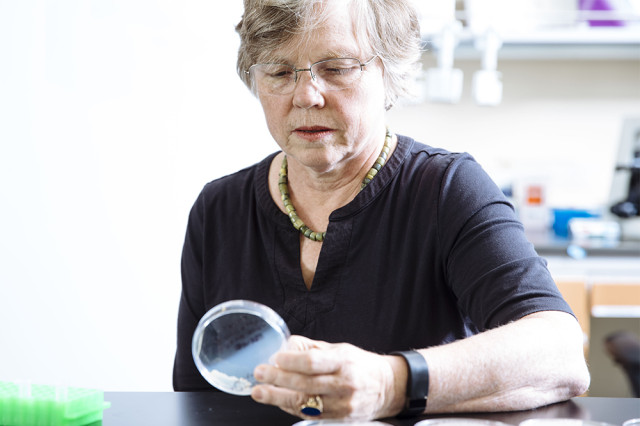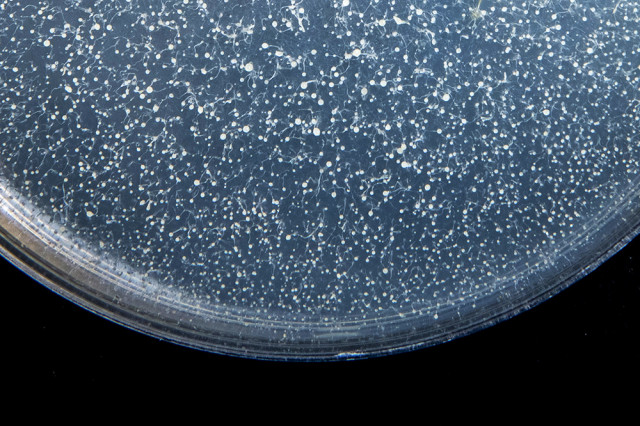As an undergraduate in the 1970s, Joan Strassmann split her time between writing short stories and laying siege to the office of her mentor, the sociobiologist Dick Alexander. For two years, she insisted on meeting with him every Friday to discuss research, a schedule that she now thinks was probably quite an imposition. “He would give me so much reading,” she recalled, “it would take me forever. I would work night and day to finish it, and maybe this was his strategy — maybe he was hoping I’d cancel or something.” But that intense focus became one of the hallmarks of her pioneering research on social insects. ![]()
In graduate school at the University of Texas, Austin, Strassmann began to study wasps that live in hierarchical colonies, starting with a nest that was thriving in a tractor shed near the main campus. “I was really planning to work on something else, some other social organism, like ground squirrels,” said Strassmann, now at Washington University in St. Louis. “Everyone knew that I was actually terrified of wasps.” But on a dare, she and a friend ventured into the shed and painted each wasp with a different identifying dot of paint, the standard preparation for studying the social dynamics of an insect colony. Then she just started watching them. And watching them.

Whitney Curtis for Quanta Magazine
Joan Strassmann, a biologist at Washington University in St. Louis, studies cooperation and social behavior in wasps and amoebas.
She was in good company. Insects that live in cooperative colonies — ants, termites, and some wasps and bees — have fascinated scientists for more than a century because they pose an evolutionary conundrum. Darwin himself saw their way of life as a challenge to his ideas. The theory of evolution seems to predict that each individual will fight to pass on its traits, but in a colony, only a very small number of insects actually get to reproduce: the queens and their mates. The rest give up their chance to contribute to the gene pool, caring for the offspring of others instead. How could this lifestyle, known as eusociality, have evolved? How could it make sense for the ancestors of modern worker bees or wasps to give up their autonomy? It seems biologically implausible.
Right around the time Strassmann was in college, however, biologists began to understand how social insects could fit into the framework of evolutionary theory. In a seminal paper, W.D. Hamilton proposed that cooperation might make sense in closely related individuals that share enough genes. If a bee with a maiden-aunt helper produces twice as many offspring as it might have otherwise, that arrangement makes evolutionary sense for the non-reproducing assistant, which is indirectly passing on its genes. But that benefit is reduced as relatedness declines, so eusociality would only arise among close relatives.
Strassmann found clear evidence of Hamilton’s idea in her tractor-shed wasps. When a nest is destroyed, its members will disperse to sister nests in a pattern that reflects their level of relationship to the queens. Each wasp serves only the leaders it is most closely related to. Strassmann continued to study wasps over the next 20 years with her husband and collaborator, David Queller, and the two have uncovered many other details of how relatedness shapes the behavior of social insects, including how colonies keep relatedness high when multiple queens reign, and what it takes to turn a worker into a queen.
About 17 years ago, however, the pair began to shift to a new model organism, the amoeba Dictyostelium discoideum. They suspected that this unusual creature could offer new insights into the dynamics of cooperation. In moments of starvation, these soil-dwelling amoebas crowd together and build a tower rising above the ground from which they disperse their spores to other, more hospitable places. Some 20 percent of the group will sacrifice themselves to build the tower with their bodies, while the rest take advantage of it to spread their genes.

Whitney Curtis for Quanta Magazine
The social amoeba Dictyostelium discoideum can function independently as single cells or work together as a multicellular aggregate.
Quanta Magazine spoke with Strassmann about the evolution of social insects, the secret lives of queen wasps, and what she’s learned about cooperation from a single-celled creature. An edited and condensed version of the interview follows.
QUANTA MAGAZINE: You began to study social wasps just as scientists were debating the origins of eusociality. What was that like?
JOAN STRASSMANN: It was a really exciting time. W.D. Hamilton’s paper came out in 1964, but it wasn’t really appreciated until the early ’70s, when I was in college. He outlined the framework of something called inclusive fitness, which is the sum of the effects of an individual’s actions on its own and others’ reproduction. Ultimately, it is the measure of an individual’s actions on the representation of its genes in the next generation.
You would help relatives, because they share genes with you. But it’s not quite as simple as that. People often act like you’ll always help a sibling more than a cousin, and so on, but the costs and benefits are really crucial. For example, you wouldn’t help sisters who share half your genes unless they would have at least double the number of progeny as a result of of your help.
Relatedness is easy to assess with molecular techniques. Assessing the costs and benefits, though, requires that you really understand the biology of the individuals in their natural habitat. Dave and I have a paper laying out two major benefits social insects gain from joining forces: fortress defense, where two of you can guard better than one, especially if you live in a nest with a tiny opening; and life insurance, where if one of you dies, the other ensures the survival of your babies. Fortress defense and life insurance are the two main reasons that cooperating could be beneficial in social insects.
Are there behaviors or traits that make it easier to become eusocial?
Yes — they’re actually very well known. The ancestors of social insects are parasitic wasps. As a parasite, you don’t want to make your host sick until you’re going to kill it, so these wasps don’t really poop as larvae. They just sort of hold it in. The same goes with social insects — you really don’t want to poop in the nest. How you control the poop in social organisms is a really important question.

Whitney Curtis for Quanta Magazine
When starved, Dictyostelium swarm together to form a fruiting body.
Then there is maternal care. A solitary wasp paralyzes its prey and lays an egg on it to provide for its offspring. The next step in the evolution of eusociality is that daughters stay with Mom and help her rear more babies. This can be for life-insurance or fortress-defense reasons. It just makes sense.
For a while, people thought that eusociality could have arisen purely from aggregations of unrelated individuals. Lots of wasp species nest together in aggregations. You can see them in banks on streams and sand dunes and lots of different places.
But those aggregations are fundamentally selfish. A wasp in the middle of a swarm is less likely to be hurt than one off on its own — that’s the payoff there. Those aggregations never lead to eusociality. You only get eusociality through what they call a subsocial path where daughters stay with Mom, so they’re already highly related.
You gave up wasps for a single-celled creature. That’s a huge jump. Most people don’t change model organisms midcareer.
It was kind of an insane thing to do. Especially since we had been studying wasps in Tuscany. We know Italian, we’ve lectured in Italian, we have a lot of really good friends there … yeah. It’s insane!
The amoebas must have been doing something really amazing for you to change.
All social-insect people know about Dictyostelium because it has a solitary stage and a social stage. The single cells eat bacteria by engulfment, they live in soil, and so on. But when they starve, they aggregate and form a multicellular body that crawls toward light and ultimately coalesces into a structure called a fruiting body. About 20 percent of the cells form a stalk. The others flow up to the top and form spores, which are then dispersed. Conceptually, this can be viewed as similar to a social-insect colony. The stalk is the workers — they don’t get to reproduce, but we think they enhance dispersal of the spores.
But if the Dictyostelium cells in that multicellular body aren’t all genetically identical, are some sacrificing themselves for others with whom they have nothing in common? You know how I told you the only way groups evolve eusociality is by daughters’ staying with their mothers? The idea that you would get eusociality from aggregation seems really wrong. There should be too many conflicts there. Who’s going to die, who’s going to become the spores, and so on. There were some obvious questions to ask.
In 1998, scientists had sequenced the Dictyostelium genome but hadn’t published it yet. We knew we’d be able to plunder it for relatedness analysis. Dave and I just reached the point where we felt, “Wow, we’ve thought of this — we are going to feel like damn fools if somebody does this instead of us.”
So what did you do?
I got on the Internet and discovered there was a Dictyostelium email list. I just started posting questions. I wanted to know whether two different strains would still form a fruiting body together.
The first study we did, we found that different strains do mix, and they do cheat. Two different strains will not contribute equally to spore and stalks. One of them is taking advantage of the other. So this is a good way to look at social organisms.
Why does that make them a good model?
Because there’s conflict — social competition.
How conflicts are controlled in social organisms is a major topic of evolution research. In eusocial organisms, controlling conflict — through castes, for instance, which make it very clear who gives way to whom — allows them to live together.
In Dicty, where some take advantage of others, we can ask questions about how they manage the conflict so as to allow this form of sociality to persist.
What made Dicty really attractive was that we could ask “why?” on a mechanistic level, because we could knock out genes and do all those things that cell biologists do. That was super-exciting to us. It’s just been fabulous. We’ve found that there are over 100 genes that, if inactivated, will cause a Dicty strain to begin to cheat, for instance. That suggests that the genetics of sociality in Dicty is complex.
And we’re moving into bacteria now. We found some insane relationships between bacteria and Dicty: For instance, Dictyostelium actually appear to farm bacteria for their own consumption! So we’re not working on wasps at all. It’s sad but true.
Now you’re trying to define what it means to be an organism?
We feel that defining the actual key characteristics that make an organism has never been properly done. People have proposed requirements “genetic uniformity,” “all connected together” and “single-cell bottlenecks” — that means that there’s a phase where the organism is just a single cell.
None of them really hold up — plants don’t have single-cell bottlenecks, for instance. Working on Dicty, you realize how narrow-minded most biologists are. They are so blinded by a very few organisms. If you want to think about what an organism is, you can’t start with a mouse. You can’t! You have to start with, well, is a biofilm an organism? If it is, why? If not, why not?
What Dave and I came up with — and this is mostly Dave — is that what makes an organism is the level at which there is the highest level of cooperation and the lowest level of conflict. If the parts, whatever they are, are largely cooperative and whatever conflict there was has been controlled, that’s an organism. Our plan is to write a book on this.
My favorite example is the Portuguese man-of-war. They say it’s not an organism, that it’s a colony of lots of little organisms. No — it’s an organism! I’m sorry!


Spread the word